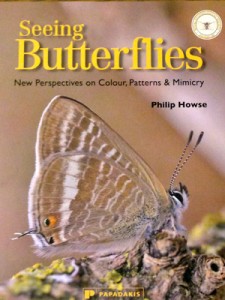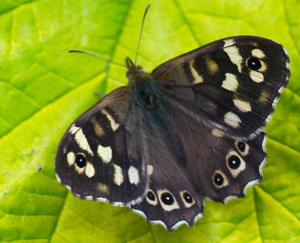“Seeing Butterflies”, a book by Philip Howse

Philip Howse’s new book ‘Seeing Butterflies’ tries to understand the reasons behind butterfly colours, and is packed with beautiful pictures and explanations.
There are 59 species of butterflies in the UK, but you are most likely to see large white, gatekeeper, peacock, and comma butterflies. Grizzled skipper, wood white and peal-bordered fritillary butterflies are woodland ‘specialists’, but population numbers have widely declined partly due to a move away from traditional woodland management practices. Over half of all butterfly species are in decline, and this is even greater among those butterflies found in woodlands. When these butterflies are seen, their presence should be recorded and can even be officially reported during July and August. The Butterfly Conservation’s Steve Wheatley explains that the presence of woodland butterflies is not only important from the butterfly conservation front, but also woodland butterflies can tell us a lot about small woodlands and how they are managed.
During the winter months butterflies will not be seen in small woodlands because of low temperatures and high rainfall. When heavy rain falls in the summer months this can also be problematic for butterflies, as the rain means the temperature will be too low for them to fly and consequently mating becomes less likely. In recent years the wet weather has threatened the existence of some of the UK’s rarest butterflies.
 Philip Howse’s book devotes particular attention to exploring butterfly colours. The conventional explanation for the colour patterns on butterfly wings is that they enable one individual to recognise others of the same species and so prevent interbreeding, and that the colours and images on butterfly wings are not primarily for protection against predators. Howse challenges this by explaining that insect predators see a much greater range of colours than we do, so they focus on details rather than whole objects. Engraved on the wings of many butterflies and moths are images that closely resemble millipedes, frogs, spiders, caterpillars, and other animals and insects.
Philip Howse’s book devotes particular attention to exploring butterfly colours. The conventional explanation for the colour patterns on butterfly wings is that they enable one individual to recognise others of the same species and so prevent interbreeding, and that the colours and images on butterfly wings are not primarily for protection against predators. Howse challenges this by explaining that insect predators see a much greater range of colours than we do, so they focus on details rather than whole objects. Engraved on the wings of many butterflies and moths are images that closely resemble millipedes, frogs, spiders, caterpillars, and other animals and insects.
In this new book, Philip Howse not only develops new ideas about insect appearances, but he also dedicates chapters to describing the main groups of butterflies and moths. The latter is particularly useful in aiding identification for those interested in butterflies in small woodlands. The book’s excellent high-quality photography on every single page make it well worth buying.
You can get a copy of the book for £15 from Amazon
Comments are closed for this post.
